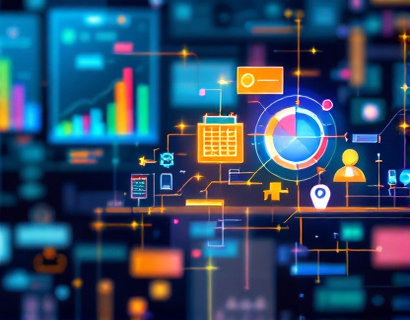AI-Powered Mental Health Navigator: Enhancing Access to Specialized Insights for a Diverse Audience
The integration of artificial intelligence in mental health services has opened new avenues for providing specialized insights and support to a wide range of users. An AI-powered chatbot designed to navigate the complexities of psychiatric services and the mental health industry offers a unique solution. This platform ensures content accuracy and safety, making it an invaluable resource for children, students, educators, and healthcare professionals alike. The chatbot's primary goal is to foster confident and responsible engagement with mental health topics, breaking down barriers to access and understanding.
Understanding the Need for Specialized Mental Health Information
Mental health is a critical aspect of overall well-being, yet it remains a topic shrouded in stigma and misunderstanding. The demand for reliable, accurate, and accessible information is higher than ever. Traditional sources of information, while valuable, often fail to cater to the diverse needs of different user groups. Children and students require content that is both educational and age-appropriate, while healthcare professionals need in-depth, evidence-based information. Educators, on the other hand, seek resources to effectively discuss mental health with their students. An AI-powered chatbot addresses these varied needs by providing tailored insights and support.
Key Features of the AI-Powered Chatbot
The chatbot is designed with several key features to ensure it meets the needs of its diverse user base. First, it offers specialized insights into psychiatric services, covering topics such as therapy options, medication management, and crisis intervention. The chatbot draws from a comprehensive database of information, ensuring that the content is up-to-date and accurate. This is crucial for users who rely on the chatbot for making informed decisions about their mental health or the mental health of others.
Content verification is a cornerstone of the chatbot's design. Every piece of information provided undergoes rigorous checks to ensure its reliability and safety. This is particularly important for younger users, who may not have the critical thinking skills to discern accurate information from misinformation. The chatbot's content verification process includes cross-referencing with reputable sources and adhering to strict editorial guidelines.
Tailored Content for Different User Groups
The chatbot is programmed to recognize the user's profile and tailor the content accordingly. For children and students, the language is simplified, and the topics are presented in an engaging and accessible manner. The chatbot uses age-appropriate examples and analogies to explain complex concepts, making mental health more relatable and understandable.
For educators, the chatbot provides resources and guidance on how to discuss mental health in the classroom. It offers lesson plans, discussion prompts, and tips for creating a supportive environment. Healthcare professionals gain access to detailed case studies, research findings, and best practices in psychiatric care. The chatbot also includes a section for healthcare providers to share their experiences and insights, fostering a community of knowledge exchange.
Ensuring Safety and Responsibility
Safety and responsibility are paramount in mental health discussions. The chatbot is designed to handle sensitive topics with care, providing reassurance and guidance without promoting self-diagnosis or self-treatment. It clearly states that it is not a substitute for professional help and encourages users to seek assistance from qualified mental health professionals when needed. The chatbot also includes emergency contact information and resources for immediate help, ensuring that users have access to critical support when required.
To further enhance safety, the chatbot monitors user interactions and flags any content that may be harmful or inappropriate. It uses advanced algorithms to detect and prevent the spread of misinformation, ensuring that all interactions are constructive and beneficial. This proactive approach helps maintain a safe and supportive environment for all users.
Promoting Confident Engagement with Mental Health Topics
One of the most significant benefits of the AI-powered chatbot is its ability to empower users to engage with mental health topics confidently. By providing accurate and reliable information, the chatbot helps reduce the stigma associated with mental health issues. Users, regardless of their background or level of knowledge, can explore topics at their own pace and gain a deeper understanding of mental health concepts.
The chatbot also encourages users to ask questions and seek clarification on any doubts. This interactive approach not only enhances learning but also builds trust in the information provided. Users feel more confident in their ability to navigate mental health topics, which is essential for both personal well-being and the well-being of those around them.
Supporting Mental Health Education and Awareness
The chatbot plays a vital role in promoting mental health education and awareness. For students, it serves as an educational tool that complements classroom learning. Educators can integrate the chatbot into their curriculum, using it to spark discussions and provide additional resources. The chatbot's ability to adapt to different learning styles and levels makes it a versatile educational resource.
For mental health enthusiasts and professionals, the chatbot offers a platform to stay updated on the latest research and trends in the field. It provides summaries of recent studies, insights from leading experts, and practical applications of new findings. This continuous flow of information helps users stay informed and equipped to address mental health challenges effectively.
Technical and Ethical Considerations
The development of an AI-powered chatbot for mental health involves careful consideration of technical and ethical issues. The chatbot uses natural language processing (NLP) to understand and respond to user queries accurately. It is trained on a vast dataset of mental health information, ensuring a broad knowledge base. However, the chatbot is not designed to replace professional mental health services. It clearly communicates its limitations and encourages users to seek professional help when necessary.
Ethically, the chatbot adheres to strict privacy and data protection standards. User interactions are anonymized, and personal data is handled with the utmost care. The chatbot also complies with relevant regulations and guidelines, ensuring that it operates within legal frameworks. This commitment to ethical standards builds trust and credibility among users.
Case Studies and Real-World Applications
Several case studies demonstrate the effectiveness of AI-powered chatbots in mental health support. In one scenario, a school district implemented the chatbot as part of its mental health program. Students and teachers reported increased awareness and reduced stigma around mental health issues. The chatbot provided valuable resources and support, helping students manage stress and anxiety more effectively.
In another instance, a healthcare organization used the chatbot to pre-screen patients for mental health concerns. The chatbot directed users to appropriate resources and professionals, streamlining the healthcare process and improving patient outcomes. These real-world applications highlight the chatbot's potential to make a meaningful impact in the mental health sector.
Future Developments and Expansion
The future of AI-powered mental health support is promising, with ongoing developments aimed at enhancing the chatbot's capabilities. Plans include integrating machine learning algorithms to improve the chatbot's understanding and response accuracy over time. Expansion into new languages and cultural contexts will make the chatbot more accessible to a global audience.
Collaborations with mental health organizations and research institutions will further enrich the chatbot's knowledge base. The goal is to create a comprehensive and dynamic resource that continues to evolve with the needs of its users. By staying at the forefront of AI and mental health innovation, the chatbot aims to be a leading tool in promoting mental well-being.











































